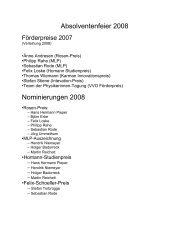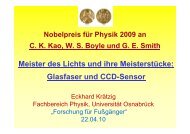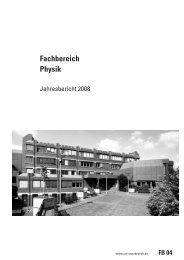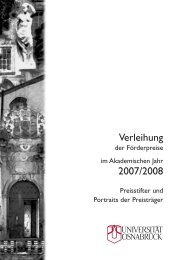Universität Osnabrück, Graduiertenkolleg Mikrostruktur oxidischer
Universität Osnabrück, Graduiertenkolleg Mikrostruktur oxidischer
Universität Osnabrück, Graduiertenkolleg Mikrostruktur oxidischer
Erfolgreiche ePaper selbst erstellen
Machen Sie aus Ihren PDF Publikationen ein blätterbares Flipbook mit unserer einzigartigen Google optimierten e-Paper Software.
70 UNIVERSITÄT OSNABRÜCK, FACHBEREICH PHYSIK<br />
To study the very basic properties of catalytic systems, mathematical models, which are less detailed, are of<br />
particular importance. One of such models is the Lotka-type model introduced for a simplified description of the<br />
autocatalytic surface reactions by Mai et al. [6] and further employed in a series of papers [7]-[9]. This is a single-parameter<br />
model, with two kinds of reactants labeled hereafter as A and B. Reactants A (B) can be adsorbed<br />
(desorbed) with the adsorbtion (desorbtion) rate ζ (1-ζ), respectively. The autocatalytic reaction step A+B→2B<br />
takes place instantly if A and B are nearest neighbors (NN). It was shown that reactant concentrations exhibit<br />
here stable oscillations independently of lattice size [6].<br />
Diffusion of reactants in real catalytic surface reactions is a very quick and important process, which can lead to<br />
a formation of aggregates, clusters and other spatial structures [10]. This is why of particular interest are those<br />
mathematical models which take into account diffusion of reactants. The studies of chemical reaction kinetics<br />
with mobile reactants have a long history [5]. The diffusion is implemented usually as random walks on the<br />
lattice with and without energetic interaction between reactants. For example, the coagulation effects as diffusion-controlled<br />
processes were studied for A+B→inert reactions by Silverberg and Ben-Shaul [11]. The Ziff-<br />
Gulary-Barshad (ZGB) model, which mimics the catalytic CO+1/2O2→CO2 reaction, had been also extended for<br />
diffusion of reactants on a regular surface [12]-[14], diffusion on a reconstructing surface [15] and for diffusion<br />
and energetic interaction between reactants on a regular surface [16]. Chemical reactions with mobile and energetically<br />
interacting reactants on a reconstructing catalytic surface were studied by Zhdanov (see [17] and references<br />
therein). However, almost in all papers, which deal with reactant energetic interactions, the kinetic model<br />
is not defined uniquely. For the same system different authors use transition rates of elementary processes (e.g.,<br />
adsorption, desorption etc.), which could have or have not energetic (and temperature) dependence. It makes a<br />
comparison of the results impossible.<br />
In the present work:<br />
First, the self-sustained oscillations of the Lotka-type model is used to investigate the resonance properties of the<br />
model. Namely, the control parameter ζ is periodically modulated in time with amplitude ∆ζ and frequency ωmod.<br />
Secondly, the standard Lotka-type model [6] is extended introducing diffusion of reactants. This step leads to<br />
energetically-dependent reaction rates. Contrary to previously considered models, the mathematical formalism is<br />
exploited, which defines uniquely the transition rate dependence on energetic interactions. We are interested in<br />
determining and understanding how parameter modulation and mobile and interacting reactants affects the temporal<br />
structures in the Lotka-type model.<br />
Results<br />
From the MC computer simulations for every set of external parameters (adsorbtion rate ζ, modulation amplitude<br />
∆ζ and frequency ωmod, as well as jump rate υJ and interaction energy eJJ ) we obtain the time dependence of<br />
concentrations of reactants A and B. The Power Spectral Density (PSD) analysis is performed on concentration<br />
of reactants B as a function of time (see [18], [19] for details). As a result, both oscillation frequency ω0 and<br />
amplitude at this frequency are determined for various resonance and diffusion regimes.<br />
(i) First, a standard Lotka-type model is analyzed in terms of the reactant A adsorbtion rate ζ. The oscillatory<br />
behavior is found for small ζ values, see Fig. 1. It arises as an interplay between two processes, which to a first<br />
approximation could be considered separately: Firstly, reactants A are created in lattice and they form<br />
statistically a percolating cluster. Secondly, at the same time, reactants B are mainly desorbed whereas the<br />
percolating cluster of A extends. At some moment the percolating A cluster meets one of survived reactants B<br />
and thus it is transformed from a cluster of A ’s to a cluster of B’s. The cycle then repeats once again, reactants<br />
B desorb and reactants A form a new percolating cluster.<br />
To distinguish between oscillatory and non-oscillatory behavior, we postulate that the non-oscillatory region<br />
occurs, when visually one can see no longer oscillations. The corresponding PSD amplitude, which separates<br />
these two cases, is 0.007 – see dashed line in Fig. 1. The amplitude in the non-oscillatory region (below the<br />
dashed line) is approximately seven times less than the maximal amplitude obtained in the oscillatory region.<br />
Besides the shape of concentration oscillations has lost the clear sinusoidal behavior, which now is distorted by<br />
a large noise level. The PSD method is so sensitive, that it can determine an oscillation frequency and amplitude<br />
even in the non-oscillatory region, since the peak at oscillation frequency is distinguishable from the<br />
background. The critical adsorbtion rate ζ, which separate oscillatory and non-oscillatory regions, can be found<br />
readily from Fig. 1 to be 0.075. The PSD amplitude’s increase observed for ζ







